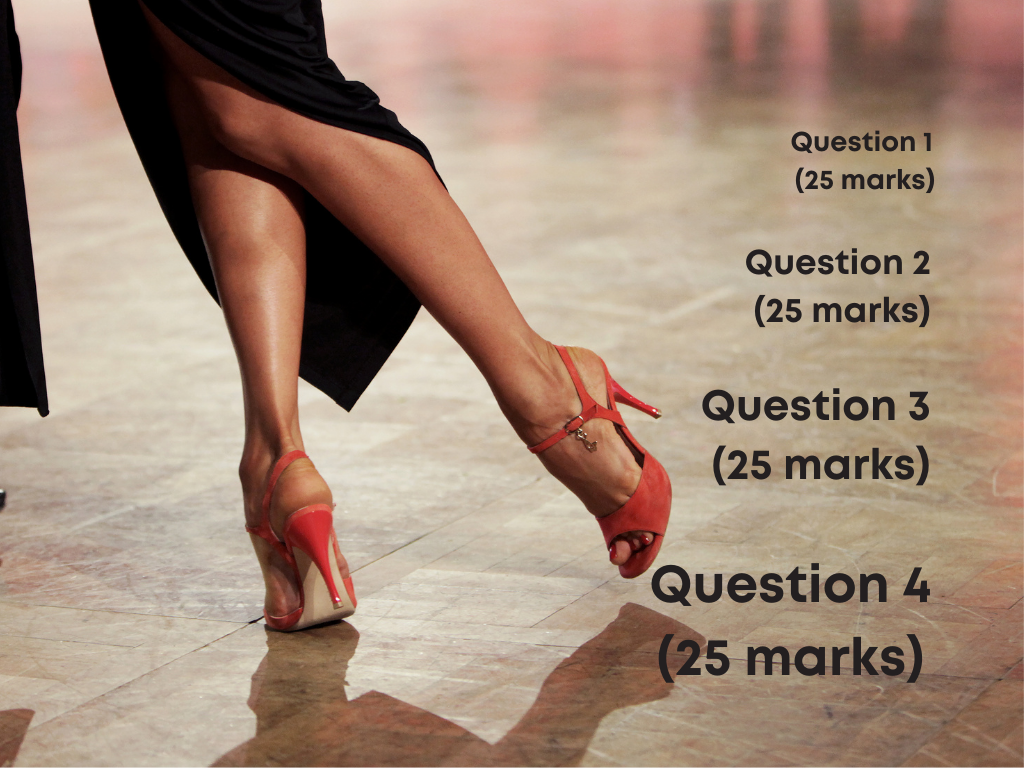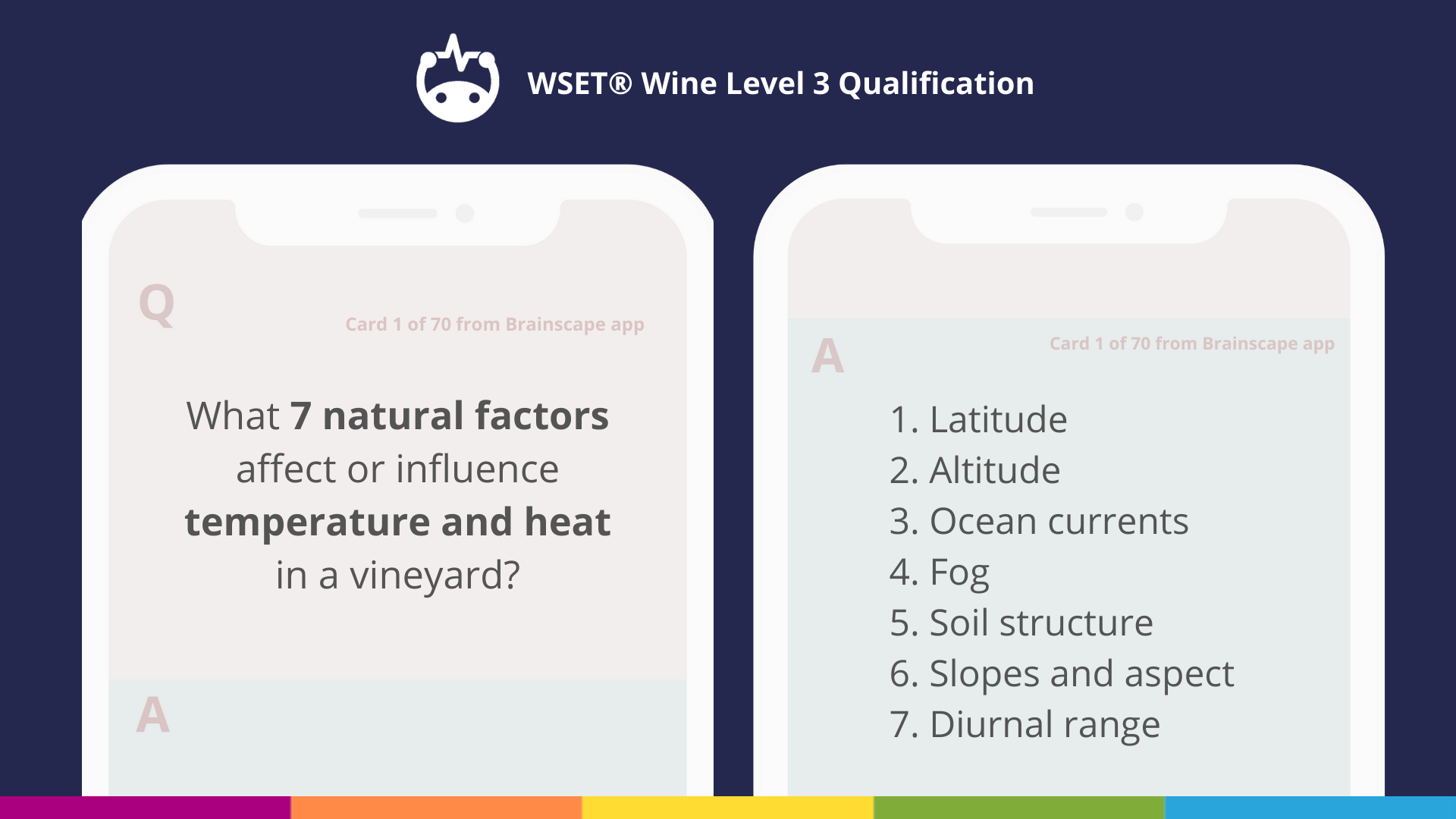What do the following have in common?
- Turbulence on an airplane,
- The sound of a surgical glove snapping,
- Going on a first date, and
- WSET short-answer questions
They all cause anxiety!
And in the case of WSET short-answer questions, they cause wine students great anxiety. You see, these questions are, by their very nature quite a bit more demanding than the WSET level 3 exam’s multiple-choice questions because they require you to write full “sentenced” answers that tie together complex pieces of knowledge into coherent and succinct answers.
Also, they account for two-thirds (100) of the marks on the written exam. No big deal, right?
The good news is, you’ve landed upon the perfect address in the world wide web to help you conquer this aspect of the WSET level 3 exam! While you can use Brainscape’s WSET level 3 flashcards to help you efficiently learn and retain every fact you'll likely be tested on, this guide will give you the strategy to approach and execute those WSET short-answer questions!
But first, two things:
- If you’ve never heard of Brainscape before, who the heck are we? And:
- What’s the deal with WSET short-answer questions anyway?
We’ll walk you through both starting, oh look at that, RIGHT NOW!
Who the heck is Brainscape?

Oh, you know, only the world’s smartest study app! But we’re also serious wine lovers: so serious that we teamed up with the redoubtable Sarah Looper—a Certified Wine Educator, Advanced Sommelier, and Master of Wine candidate—to create a collection of flashcards that give students the “secret sauce” they need to learn, understand, and remember the incredible volume of information tested by the exam.
With our powers combined, we distilled the latest official curricula for the WSET Level 3 Wine into this collection of flashcards, which use a sophisticated spaced repetition algorithm to help you learn the essential facts TWICE as fast as traditional study methods.
We’ve also curated a pretty awesome Wine Academy, stacked floor-to-ceiling with delicious (and FREE) study guides that serve up succulent advice on passing the WSET level 3 exam (or any other wine exam for that matter). Alternatively, or additionally, if videos are more your speed, watch Sarah Looper giving her best study tips on Brainscape’s YouTube channel for wine:
Anyway, now that you know who we are and why we know what we’re talking about, let’s look a little closer at the anatomy of these WSET short-answer questions ...
How do WSET short-answer questions work?
The WSET level 3 exam consists of two components. The first is multiple choice and consists of 50 questions worth 50 marks. The second contains four short-answer questions—complex topics that require short written or longer essay-style answers—each of which focuses on a specific topic and is worth 25 marks.
Now, typically, WSET short-answer questions are further broken down into several “smaller”, oftentimes related questions worth a variety of marks. For instance, the overarching topic of the section may be Bordeaux. But you may be asked:
- One question worth 10 marks,
- Two worth 4 apiece,
- Another worth 5,
- And one worth 2.
Together, these five questions yield a total of 25 marks. Get it?
And then, as mentioned, you’ll have to tango your way through four WSET short-answer question sections for a total of 100 marks.

You have two hours to complete the WSET level 3 written exam and, good news, marks are not deducted for incorrect answers. So you have absolutely zero excuses for leaving anything blank, particularly in the multiple-choice section, where, worst case scenario, you at least have a 25% chance of getting a question right.
Now, let’s take a closer look at what you can expect from each WSET short-answer question:
Question 1: Learning outcomes 1 & 2
The first question will examine you on learning outcomes 1 and 2, which, if you refer to the specifications laid out in your textbook, you’ll see are to do with wine-making processes, principal grape varieties, and the still wines of the world. So, for example, you may be asked about a wine region like Burgundy or Bordeaux.

Psst! Take a sneak peak at Brainscape’s flashcards on Burgundy and Bordeaux.
Question 2: Learning outcomes 1 & 2
Similarly, the second question will focus on wine-making processes, principal grape varieties, and still wines of the world but this time, on a different region: perhaps another in Europe, like Germany, Spain, or Portugal.
Question 3: Learning outcome 1, 2, & 5
The third question will, again, examine you on the wine-making processes, principal grape varieties, and still wines of the world and, again, on a different wine region—perhaps another in Europe or a New World wine region like California or Australia. But, this time, you can ALSO expect five marks to be dedicated to service, storage, and food pairing.
Pro Tip: You can count on this service element showing up on any one of Questions 1, 2, or 3 and then definitely again on Question 4 ...
Question 4: Learning outcome 1, 3, 4 & 5
The final WSET short-answer question examines you on learning outcome 1 as it relates to sparkling wine AND fortified wine with, once again, 5 marks going to service, storage, and food pairing.
Listen well: you are GUARANTEED to be asked a question about sparkling wine AND fortified wine (not one or the other) and that it will ALSO include a service element for 5 marks. So make sure you revise these sections well!
Pro Tip: check out Brainscape’s WSET flashcards for sparkling wines and fortified wines (Sherries, Ports, fortified Muscats and other sweet wines) if you want to learn and understand the content much more efficiently.
And for more about what’s in the WSET level 3 exam, check out ‘What are the exam topics on the WSET Level 3?’
Tips on answering WSET short-answer questions
There! Now that I’ve just about given you the cheat codes to the WSET level 3 exam, let’s finally give you the strategy to annihilate those WSET short-answer questions...
Start with the multiple-choice section first

The typically easier format of multiple-choice questions requires less deep thinking—because they give you the answer prompts, as opposed to you having to come up with the answers from scratch—and so you can ease into the exam with this section. This’ll give you a good 20 minutes to recover from any exam anxiety AND it’ll stimulate your brain and get the juices flowing.
Pro Tip: Without rushing, try to work through the multiple-choice section as quickly as possible. The more time you have for the WSET short-answer questions, the better so try to get these done in 20 to 30 minutes maximum.
Read the question carefully. What is the examiner asking for?
Yes, I know, it’s horrendously obvious. And yet students often rush into each question and, out of anxiety or lack of time (or both), regurgitate everything they know about the topic being examined without specifically addressing the examiner’s question.
So, read the question carefully, identifying the “action” or key word, which is usually one of the following:
1. Define or state: provide a simple one-sentence definition or statement.
2. Explain or describe: dive a little deeper and explain why something is true or how a process works; or describe it in a little more detail.
3. Provide an example: give a specific example of a wine, concept, or process. If it’s for one mark, keep it brief.
4. Compare or similar relationship questions: require you to state or show how two or more things relate to one another. Are they complementary? Are they the same? Are they different? Are they opposites? How does the existence of one affect the other? And so on ...
Whatever the action word is, make sure your answer specifically addresses it.
One other thing: many of the short-answer questions you’ll encounter on the WSET level 3 exam contain several of these action words, for example:
Define malolactic fermentation and give two examples of styles of still white wine where it is used in the wine-making process. Explain how it impacts the textures and aromas of these wines. (5 marks)
Here, there are THREE action words: “define”, “give two examples”, and “explain” (we’ll answer the actual question in the next section).
For every mark allocated, include a fact
Now, you’ve got to satisfy the examiner by providing a fact for every mark allocated to the question. For example, in the above question, we can see there are really five pieces of information being requested:
- Define malolactic fermentation
- Give one example of a style of still white wine that’s used MLF
- Give another example
- Explain how MLF influences texture
- Explain how MLF influences aromas
By answering each of these questions, you’ll provide enough information to satisfy the examiner and get your 5 marks. I.e. one mark = one fact.
So that answer could be:
Malolactic fermentation is the process where malic acid is converted to lactic acid (1 mark). Chardonnays from Napa Valley, California (1 mark) and the Côte d'Or region of Burgundy (1 mark) typically undergo MLF, which adds a creamy, oily mid-palate texture (1 mark) and buttery aromas (1 mark).
Here’s another example:
Q: A customer asks you for a full-bodied Chardonnay. What do you suggest and how would you serve it? (2 marks)
A: I would serve a Pouilly-Fuisse (1) and serve it lightly chilled (2).
And another:
Q: Some wine-makers use Vertical Shoot Positioning when growing chardonnay in a cool climate. Why would a grape grower choose this method? (4 marks)
A: Grapes can struggle to ripen in a cool climate (1). By using VSP, the grape grower can increase the berries’ exposure to sunlight and heat (2). Shoots are trained up wires on a trellis (3), meaning the berries are not shaded by the shoots (4), thereby optimizing exposure to heat and sunlight.
Breaking each question down this way helps you structure your answers and optimize points!
Oh, and by the way, if you’re looking for great advice on nailing the practical portion of the WSET level 3 exam, check out this awesome video on Brainscape’s Wine YouTube channel:
Write your answers out in full
What you may have noticed from the above examples is that each answer was written out in full and this is important to know when going into the WSET short-answer question section. The examiner is looking for decent explanations delivered by succinct but coherent sentences. Not bullet-point lists. So, write your answers out in full.
Keep waffle to a minimum

Also keep your answers lean and succinct. No amount of ambitious, flowery prose is going to distract the examiner from what they’re looking for: the facts. So don’t waste time trying to construct poetic sentences and sweepingly verbose descriptions. The easier you make it for the examiner to mark your paper, the better.
If you struggle with a short-answer question, begin with a bullet-point list
If you encounter a WSET short-answer question worth quite a few marks and you’re a little overwhelmed and don’t know where to start, begin with a bullet-point list. Jot down the relevant facts and then use that to construct your final answer. But, again, make sure you write that answer out in full.
Pro Tip: This is also a useful strategy if you’re in a fierce race against time; you have literally only a few minutes to answer a question and you’re just trying to squeeze whatever the heck you can out of your brain. Even if you do run out of time, the examiner will see that you are at least a little bit knowledgeable about what’s being asked and you may escape with a few points in the bag.
Watch your timing
Speaking of timing … you’re given 120 minutes to answer both the multiple-choice and short-answer questions on the written WSET level 3 exam. Our recommendation is that you give yourself at least 90 minutes to tackle the latter section; and ideally 100 minutes, which is 25 minutes per short-answer question.
If you know your stuff well—which you will if you’ve used Brainscape’s certified WSET level 3 flashcards to study alongside the official textbook—it’s more than just possible to get through the multiple-choice section in 20 minutes.
Confused? Keep movin’ to score maximum marks

And, finally, if you encounter a WSET short-answer question you’re unsure of, skip to the next question. Your first priority is to score as many points as possible in your first run by answering all the questions you know. Then, you can return for a second run-through and address the questions that require a little more thinking and planning.
Importantly, be super careful not to accidentally miss out any question!
Hey, by the way, read ‘How to take a WSET Level 3 practice test’ so that you get the most out of any practice you do ahead of your exam.
A final note: The key to acing WSET short-answer questions
So now that you understand how WSET short-answer questions work and you have a great strategy for attacking them, I’d like to end off with a word of advice on studying for the WSET level 3 exam. The real key to doing well on this exam is to not just know the facts but to understand them and how they relate to each other. (Brainscape's WSET flashcards will help you do that.)
Think about it: a bottle of wine or spirits is a symphony of interwoven elements, beginning in the soils of the vineyard and ending with a great crescendo in your glass. At this point in your learning journey, you most probably understand this. And this is how you need to study: by understanding the role each element plays in this grand orchestra and how one changed element can affect the song.
Okay, I’ll stop beating that metaphor to death but, hopefully, my point is clear. So, hold this key close to your heart as you study and follow the strategy laid out in this guide. Do this and you'll crush the WSET Level 3!
Don't miss our other WSET Level 3 study guides:
- What are the exam topics on the WSET Level 3?
- How to study for the WSET Level 3 wine exam more efficiently
- Wine tasting tips for the WSET Level 3 exam
- How to take a WSET Level 3 practice test
P.S. When you're ready to take your next step to WSET Diploma, we have expert-curated flashcards and study guides for all five modules!
